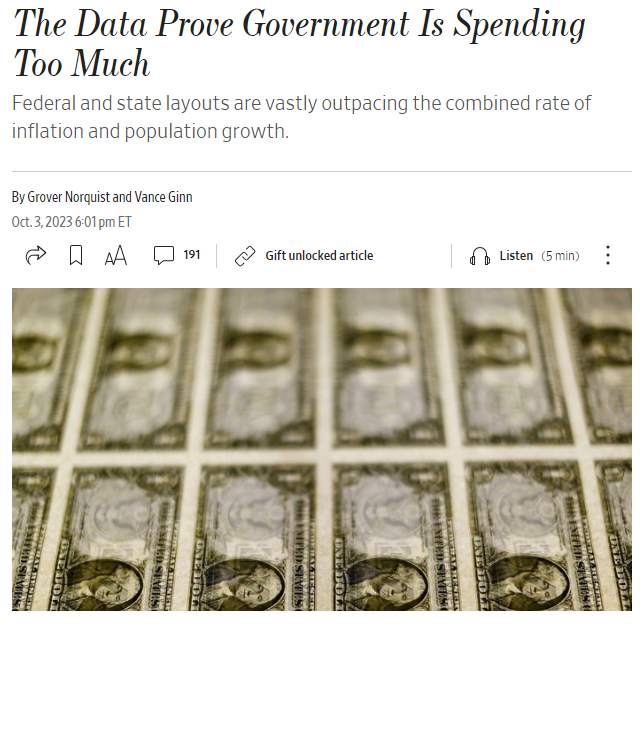|
Federal and state layouts are vastly outpacing the combined rate of inflation and population growth. The U.S. national debt recently passed $33 trillion, more than 120% of gross domestic product. Left-wing politicians assert that Americans are undertaxed, but the data show that the government spends too much.
Americans for Tax Reform launched the Sustainable Budget Project in September to document the rise in government spending over the past decade. The results are clear: Overspending is the problem. Between 2013 and 2022, aggregate annual spending by the 50 state governments, excluding federal funds, increased 51.7%. Total annual federal spending rose 69.4% during the decade, more than three times as fast as the 21.6% increase in the rate of population growth plus inflation. If government grows faster than this rate, then it is growing faster than what the average taxpayer can afford. Had the federal government limited the growth in spending to a maximum of the population growth rate plus inflation during that decade, in 2022 the federal government would have spent $1.6 trillion less than it did, resulting in at least a $200 billion surplus. If the federal government had done this over the past two decades, the national debt would have increased by less than $500 billion instead of $19 trillion. If state governments had limited spending growth to the rate of population growth plus inflation during the last decade, they would have spent $1.39 trillion in 2022, $344 billion less than the $1.74 trillion they actually spent. Had federal and state governments simply grown no faster than the rate of population growth plus inflation, taxpayers could have been spared at least $2 trillion in taxes and debt in 2022 and trillions of dollars more over time. The U.S. hasn’t needed drastic budget cuts, just slower, more sustainable debt growth. Our project defines each state’s overspending problem by providing a dollar-figure spending ceiling and allowing anyone to see how government spending in a state has grown relative to the rate of population growth plus inflation. It will publish and promote an annual benchmark spending level for every state, which lawmakers must not exceed if they want to keep state spending in check. Limiting state spending to the Sustainable Budget Project benchmark isn’t impossible. Lawmakers in more states are beginning to implement the sorts of structural reforms necessary to slow the rate of government spending to a sustainable clip. During the past decade, Colorado and Texas have demonstrated that this can be done. Colorado spent a cumulative $12.8 billion less over the past decade than what could have been available under the benchmark. State lawmakers could have dramatically cut the state’s individual income tax. Instead, there is a push in Colorado to raise taxes and destroy the Taxpayer’s Bill of Rights, the state’s constitutional requirement that all tax increases be subject to voter approval and revenue collected in excess of the state spending cap be refunded to taxpayers. Texas spent $16.4 billion less than the benchmark over the past decade, savings that could have been used to eliminate its gross-receipts-style franchise tax and other bad taxes. Rather than continuing to keep state spending in check, Texas lawmakers instead passed the largest state budget in the state’s history this year. Excessive spending at the federal, state and local levels of government deserves more attention. Tax hikes are easy to identify, but there has been no objective, binary metric to determine whether a state government spends too much. By focusing on the rate of population growth plus inflation, the Sustainable Budget Project provides such a standard. Governors and state legislators need to implement reforms and practice restraint to slow the steep upward trajectory of government spending. That lawmakers in large, politically important states have already demonstrated this ability has shown their counterparts in other states and in Washington that sustainable budgeting is possible. With more modest growth in state government spending, lawmakers can lower taxes and Americans can keep more of what they earn. Mr. Norquist is president of Americans for Tax Reform. Mr. Ginn, a senior fellow at ATR, served as chief economist of the White House’s Office of Management and Budget, 2019-20. Originally published at Wall Street Journal.
0 Comments
Leave a Reply. |
Vance Ginn, Ph.D.
|


 RSS Feed
RSS Feed